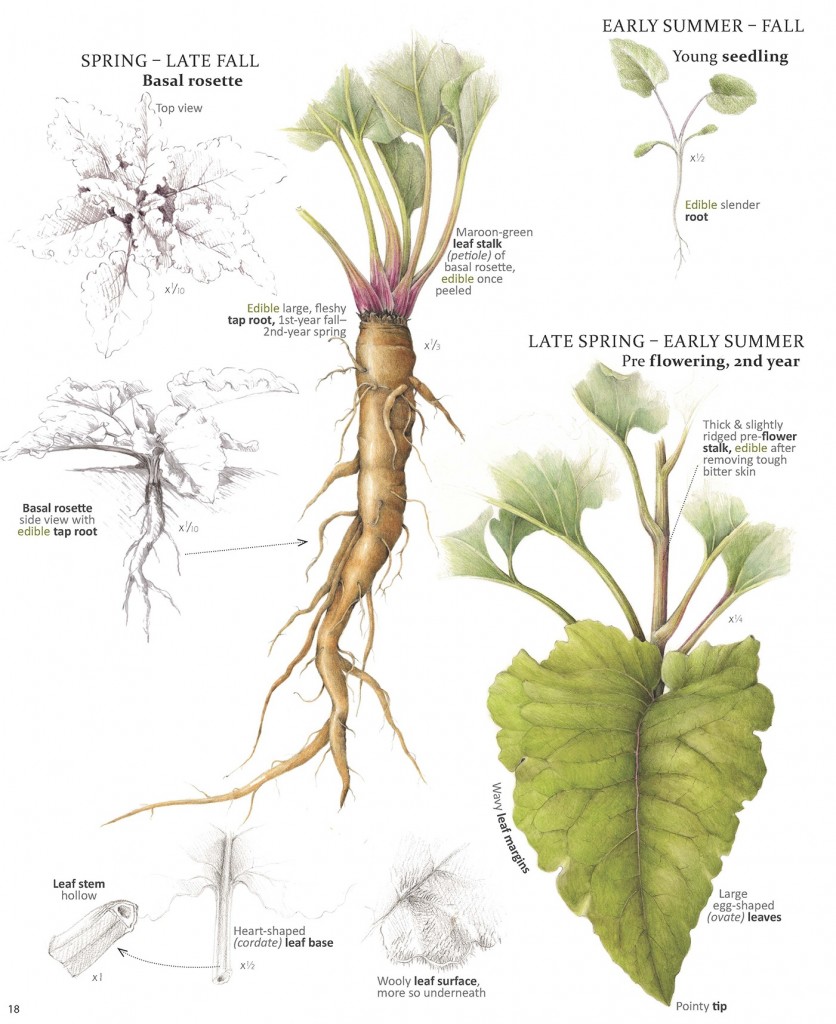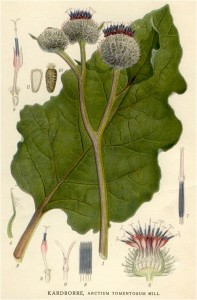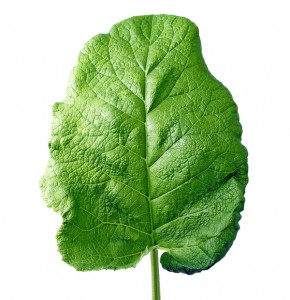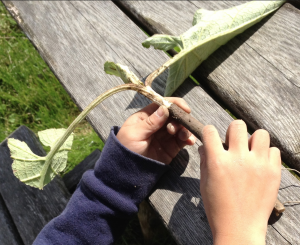Arctium spp.
Native range: Europe, Asia, and the Middle East
Invasive range: Throughout most of North America, Hawaii
Habitat: Roadside, fields, pastures
Description: Large arrow-shaped leaves grow close to the ground the first year. A tall stalk, six or seven feet tall, emerges, with purple flowers on second. Burrs, an inspiration for Velcro, provide seed dispersal. Large fleshy taproot.
Native to the Old World, burdock’s introduction to North America was noted in 1672 by John Josselyn, a sharp-eyed English visitor, who used Gerard’s Herbal: The Historie of Plants of 1597 as a field guide. In a pamphlet called New Englands Rarities Discovered, he listed “such Plants as have sprung up since the English Planted and kept Cattle in New-England,” including common burdock.
Burdock protects itself from predators by a layer of bitterness on the outside and by its thistles, so the early settlers introduced it for its medicinal properties, rather than as food. They went on to instruct the Indians in the making of a roasted-root tea to treat various ills. Among the Iroquois, young medicine men, after days of fasting, were known to drink the bitter infusion in hopes of retaining their spirit-quest visions.
BURDOCK.
Names. They are also called personata, bardona, appa major, great burdock, and clot-bur. It is so well known, even to the little boys who pull off the burs to throw and stick on each other, that I shall omit writing any description of it.
Place. It grows plentifully by ditches and water sides, and by highways, almost every where throughout this land.”
––Culpeper’s Complete Herbal, 1653
“Docks are very troublesome in our mowing ground; and, without care, they spread much by seed. They stifle the grass by their luxuriant broad leaves.”
––John Bartram, A Brief Account of Those Plants That Are Most Troublesome in Our Pastures and Fields, in Pennsylvania; Most of Which Were Brought from Europe, 1758
“Observation. Every body knows this coarse homely weed, wherever it has gained admittance,––but every body does not take care to keep it in due subjection. One of the earliest and surest evidences of slovenly negligence, about a farm-yard, is the prevalence of huge Bur-docks. The plant is considerably bitter; and the leaves are a favorite external application in fevers, head-ache, &c.”
––William Darlington, Agricultural Botany: An Enumeration and Description of Useful Plants and Weeds, Which Merit the Notice, or Require the Attention, of American Agriculturists, 1847

Drawings courtesy of Dina Falconi, Foraging and Feasting: A Field Guide and Wild Food Cookbook
Preparation
Roots
While first-year roots can be eaten raw, long slow-roasting will make them sweeter. In late summer and fall, the first-year roots, beneath the basal rosettes, can be scrubbed of their outer layer and boiled like potatoes. Here in Vermont, we harvested ours in mid-September and boiled them for about an hour before slicing them. (They can take longer to soften.) We tossed the julienned burdock with soy sauce and sesame seeds. It was simple and delicious.
The larger second-year plants move their energy from the roots to the breeding stalks and flowers are woody and inedible.
Stalks
Contributor Josey Schanen writes: “The flower stalks can be eaten like artichoke hearts and the leaf stalks like a celery-textured vegetable. The stalks are in season in late spring and early summer. The leaves are way too bitter to be worthwhile.”
Eric Garza of the University of Vermont prepares burdock roots by fermenting them, without fuel-intensive cooking. He describes his energy-postive approach, complete with a pie chart, here.
Shoots
Young shoots can be boiled until tender––longer if still bitter. Stalks taste of artichoke, a relative.
Second-year stems should be peeled before flowering and boiled 20 minutes. Seed sprouts edible.
Leaves
Young leaves, boiled, are edible but bitter. Leaf stems can be peeled and boiled. The leaves are large enough to wrap wild food in for campfire cooking, something most easily done if they are wilted by heat from the fire first.
Recipes
Gobo: Japanese Burdock
A popular Japanese dish using the taproot is kinpira gobo, julienned or shredded burdock root and carrot, braised with soy sauce, sugar, sake, and sesame oil.
Sushi rolls can be filled with kinpira gobo, which is often tinted to resemble carrot.

Dandelion and Burdock Beer
You can buy “Dandelion & Burdock” bottled in United Kingdom, with its roots in a medieval mead gathered from hedgerow plants. But why not make it yourself, from local invaders?
We’re looking forward to trying this recipe from the Guardian:
A couple of large burdock roots (about 150g)
A handful of dandelion roots (about 50g)
500g sugar (1.1 pounds)
2 tablespoons of black treacle
Juice of one lemon
Teaspoon of carragheen to help clarify the beer (optional)
Beer yeast
4.5 liters of water
Scrub and finely slice the roots then boil them with half the water (and the carragheen if using) for half an hour. Experience the aroma of an unpromising vegetable stew.
Take off the heat, add the remaining cold water, the sugar, treacle and lemon and stir until the sugar has dissolved. Strain the liquid into a clean fermenting bucket and cover.
When your brew reaches room temperature add the yeast, keep covered for up to a week then bottle in strong swing top bottles. Another week and it will be ready to drink, though it is well worth easing the top off of a bottle every now and then to check for potentially explosive levels of fizziness. Once ready it is a good idea to keep the bottles in the fridge to prevent further fermentation.
The flavor is mildly bitter and aromatic with a now pleasant hint of that vegetable stew.






























{ 4 comments… read them below or add one }
A trick to harvesting wild burdock root – dig a deep hole next to the root, and then gently pull the root free of the surrounding dirt into the hole. The roots are fragile, and go a very long way down into the soil, so it can be a lot of work to win them free, especially in rocky soil.
In the spring, harvest as soon as the soil defrosts and well before the 1st year plants start growing that center stalk.
Somehow the Asians grow them for market – and the roots are > 4 feet long when sold – they must be growing them in sand!
Huh! So these burdock weeds are edible! Just finished pulling some out on the edge of a park asphalt path that winds through a remnant mature deciduous forest (sugar maple-american beech-ash(defoliated)-white pine-white oak) in South Common Multiuse Park, MISSISSAUGA, Ontario, Canada (Burnhamthorpe Rd. – Glen Erin Dr., SE quad.) where they, with this year’s more plentiful rains, are making territorial gains into the forest’s sun dappled areas. Next to it – also pulled – are the noxiously abundant Garlic Mustard; have eaten neither. The local conservation authority planted native trees some years back and the elephant-eared burdock leaves are spreading into those areas too intercepting water from passing showers that the tree saplings need. Articles like this should be encouraged to be reproduced by local newspapers; there’s one chap here that does damage to native Riverbank Grape vines by picking their leaves to eat…if someone could only steer him to burdocks and garlic mustard.
Tasty ate some thought it was perfect
Delicious! (the article and the food choice!) My Japanese cookbook spells it kimpira gobo, I think. We sauteed the julienned roots in oil and soy sauce, as yours does, but added lots and lots of freshly ground pepper. Yum!!